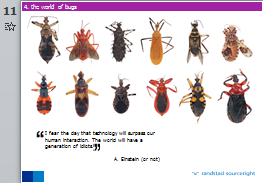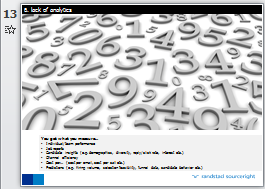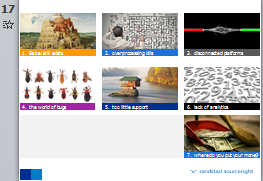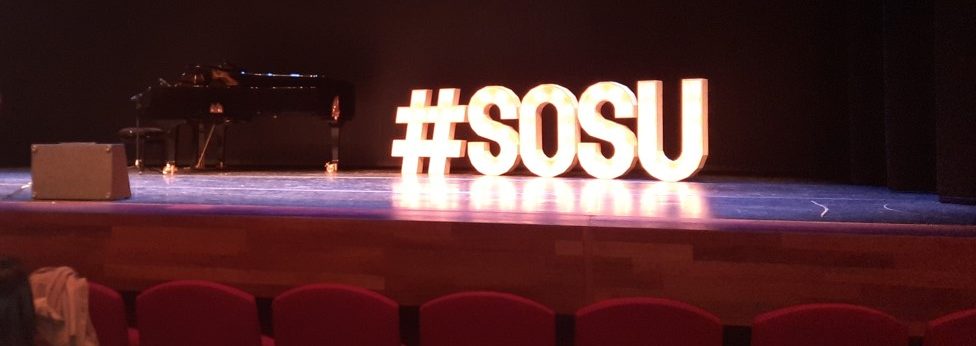IT’S ALL ABOUT TECHNOLOGY… OH WAIT! IT’S NOT [SLIDES] FROM #INTELLIGENCE16

I had the great pleasure to present on Textkernel’s 15th birthday conference in Amsterdam. Imagine a room with some 3-400 attendees and with presenters coming from all parts of the world of technology. Among these super-smart professors and other top speakers like Glen Cathey and Bill Boorman I was playing the grumpy role of the devil’s advocate. One always needs to go against others, right? 😉
Below is my script, thoughts and slides about how I see sourcing technology today.
—enjoy!—
slide 1
Whenever I speak about sourcing people get excited.
As excited as for a long time I thought it was… because of me? Maybe it is my personal impact on people or the very passionate way I speak about this profession. Feeling so sweet, right?
Well… after a while I had to understand I was not any close to reality. When people understand I do sourcing they get excited not because of me but because of this…
slide 2
Technoloooooogy!!!
Oh yeah! Sourcing is the geekiest science & art of recruiting – per perception. The cool stuff where everyone is much attached to tech. To all those tricks and hacks and gigs and cracks. The magical world of applications, plugins and Chrome extensions.
When I say I am a sourcer people ask…
slide 3
this… and
slide 4
this… and
slide 5
this!
Everyone wants to know the what. The tools I use to discover the secret arsenal of my sourcing toolkit. Everyone thinks tools are my ultimate power and I can share the secret with them.
This gives me hard times! Not only because I firmly believe there is no such a thing as a secret sourcing tool but also because people just don’t accept it. They don’t believe in that – people want to believe in fairy tales.
The best I could do was to look for a quote from a globally recognized leader. I certainly chose Glen Cathey…
slide 6
…or at least I hope this quote is from Glen Cathey.
With this analogy my aim was to make people better understand what the exact role of tech is – and what else we also need beyond tech.
The quote says: every search on LinkedIn starts with 450m profiles and all you’ve got to do is to narrow down to the best results. Pure wisdom – something only a Grand Master can explain that clearly and simply. If tech is the ultimate answer – why some can still do a better job on LinkedIn than others?
There are no secret weapons, no silver bullets, no any magical sourcing toolkit.
The very first sad lesson on the ground is…
slide 7
… there is no secret ingredient. It’s just you.
It’s not necessarily the what but the how you do things in sourcing. That differentiates you from all the others.
Technology is critical and we all live in a love/hate relationship with tech. I did recently post about my favourite sourcing toys. Love ’em all! But besides using tech in a right way you’d also need to understand the limitations, the no-go’s, the little dirty side of tech.
I built a list of 7 observations that I constantly use to assess vendors. These are, per my experience, the biggest barriers – still, only too few people talk honestly about them. As long as, however, we do not see the whole picture (but let tech simply blind our mind) we don’t have the right discussion.
These 7 arguments are below – would love to hear your thoughts!
slide 8
Number one – Babel still exists
Ludwig Wittgenstein said that “The limits of my language means the limits of my world. All I know is what I have words for.”
The today recruiting technology is heavily US and partly UK driven – primarily English-speaking. For many that looks all fine. The world I am coming from, however, sees challenges here.
Did you know that beside that 350-450 million native English-speaking people there is only approx. 900 million more who speak English as their second or third language? This is approx. 1,2-1,3 billion people that can somehow connect (or be connected) to the new recruiting and sourcing technology. The rest 5 billion people on the planet, however, are left out. They will never get there.
This is only 1 out of 5 that fits to this English-speaking tech monopoly. Quite poor ratio!
Language does have a serious impact in the world of sourcing think about searching, parsing, matching, assessment, and engagement. It’s not just that you need to find some synonyms on a local language and apply. Actually, most of the time you cannot even find those words. Google is usually useless here.
Go to Google Translate and look up the English to German translation of the word ‘manage’. You will get tens of results – all look different and you’ll see no correlation among these words. For someone that does not speak German this is where the real chaos starts. Which one to use? Which one is the right word for manage? What can be the slight differences among these words? Are these all in practice today? And most importantly: which one would my candidates use on their profile?
Replacing an English word with a foreign one – that’s not the real challenge. The real struggle, eventually, is that you have no clue which words you would need to be looking for if you don’t speak a language. The limits of my language means the limits of my world. This is what I call Babel… The world cannot be seamlessly translated.
But this is not searching only. It is searching but also parsing and matching technology. Textkernel is doing a pioneer and excellent job here and we cannot be grateful enough for them. They can match 6 or 7 languages as of today… that’s good and there are only few more thousands languages out there.
When I hear about automated, robotized engagement… well, hopefully, I do not need to explain how little these systems know today about language and how far we are from that big universal dream. Textio, Crystalknows only work in English, IBM Watson Personality Insights are proud to provide solutions in 2-3 languages…
Last time I tried IBM Watson’s Personality Insights I put three of my blog posts in English and got three different results for my personality. Ok, this is yet a demo environment and maybe I indeed have three personalities… 😀 but you’ve got it, right? Accuracy is a serious question. And that’s all dependent on the language.
Often I hear that sourcers will have no job in 5 years or so as searching and matching will be automated. If this is true then why even Google translate is still not able to do a proper job? That’s the best search engine on the planet and still… I think we are not yet there. I think we are actually way too far from these dreams.
Yes, we will surely have a job in 5 years and 5 years is a long enough time so rather let’s get prepared. Make sure you know the basics of searching. The fundamentals! The mastery of searching – keep that knowledge, you’ll have a need for that.
slide 9
Observation two – overprocessing kills
Technology was brought in to make things work faster, better and with more efficiency. Technology was there to underline our procedures and support them.
Technology today seems to change this concept. We have to understand, that in the world of applification, technology creates new procedures – and the more technology we have in place, suddenly, the more overwhelming sub- and micro-processes we have to run.
Again, people often don’t really realize it. Many, who have an ATS in place, still start every new search on LinkedIn. Why?
What is the point to start a search on LinkedIn if we can find many of the same candidates in our ATS? With contact details. And comments. Hopefully with historical selection data, emails, notes and so…
One of the big recruitment agencies in Europe made an analysis last year on source of hire. They checked which percentage of their placed candidates could have been actually found within their ATS. Candidates that were already there but the consultants did not use the ATS data but rather went for other channels to source them again. From scratch. So what’s this number? It was 80%! 80% of their placed candidates were already in the ATS. 80% overprocessing.
Today technology builds the world of constant possibility. But possibility does not mean necessity. You need to get to this concept.
With every new app, plugin or extension you bring in a new micro-process – be aware of that. Make sure you still clearly see what’s ahead. The right question often is not the what-to-use but the when-and-why-to-use. You must help and tell your sourcers when they should not and when they must use a piece of technology. Or a platform like GitHub. Or a tool. Or run a deep web search instead of running a search somewhere else.
Just because we can use technology it does not mean we always should.
Overprocessing kills. Kills time. Kills efficiency. And unfortunately, often kills creative human thinking. And that’s something we surely don’t want to lose.
slide 10
Three – disconnected platforms
We already talked about the applification of everything. Today is a fragmented tech world where there is an app for everyone’s interest.
The big question in sourcing and recruiting is data integration or as Bill Boorman usually calls it: the aggregation of data.
There are multiple contradictory points here! Let me pick just one.
Candidate experience… On one hand we want to do our very utmost to impress, attract and please candidates while on the other hand even the minimum CRM capabilities are not in place. Therefore, we contact candidates multiple times, ask the same questions that our colleagues did before, make them apply again for a role they were recently rejected etc. Craziness! We disaggregate data and we don’t care about that.
It was always an easy decline for me to say no to LinkedIn’s CRM solutions as I never wanted to have double (or triple) tracking. Why would that be any good? Why would that benefit our business if sourcers would track things (candidates, communication, feedback etc.) on various platforms? No integration is the new dirty.
Every time you turn to a new platform (being it a social network, a chat system or so) you lose data. However, data you own is the only knowledge you can gather.
Take care about the fragmentation and fix it. Stop data leaking. Aggregate and integrate. You control it.
slide 11
The world of bugs
Some months ago when connectifier was acquired by LinkedIn the regular industrial panic was waving on Facebook. The most shocking comment was: ‘thanks God I still remember Boolean so that I can replicate these searches’.
Are we really that heavily reliant on tech? Do we purposefully lose common sense and the knowledge of fundamental practice just because a tech provider appears and creates a (more-or-less) fake promise?
Stop complaining about the world of bugs. Those will never disappear. On the very contradictory, those will be the new standard, the number of bugs and down-times will just increase. The buggy world. A world with constant shut-downs.
You’d rather calculate it into your productivity measures. How much time do you lose because of bugs? 3%? 5% or even more? Serious hidden topic.
slide 12
Too little support
————————————————–
————————————————–
————————————————–
This is what you feel in Europe during an early morning system shut-down knowing your US-based HR tech start-up is still sleeping. No more comments.
slide 13
Lack of analytics
Talking about big data solutions when you cannot export a simple report from your ATS – how interesting is that!
Big data solutions will not solve anything tomorrow if you don’t build the fundamentals of data processing today. And that is not just getting access to data – not only the technical part.
The serious action with analytics is the mindset change. It’s to understand what data you can use and for which purposes. A new way of thinking. Falling in love with data combination. You feel comfortable in this world? You die to understand the correlation between source of hire and date of application (or length of CV, for instance, to make a slightly more interesting jump)? That’s the right start. If not – then stop dreaming about big data and first complete your homework.
slide 14
And the last one, the seventh argument: where do you put your money?
When you complain about how expensive a LinkedIn product is just run a simple cost analysis. Maybe you’ll understand LinkedIn is not expensive at all.
What costs more? This is the right question. 2 minutes extra search per candidate on Google or to buy a people aggregator? Sending a LinkedIn InMail or picking up the phone? Ask more of these questions and you’ll get better clarity on tech ROI.
Tech can be super expensive – well, according to Josh Bersin HR tech was a $15 billion market in 2014. Probably little more worth today. See things in correlation. Beside tech cost you’ll always have resource cost, time, other equipment etc. Ask complex questions and they will help you make a better choice on investment.
Don’t get me wrong – I am not against tech. Not at all. I live with tech but use these arguments to control and manage the overwhelming offer tsunami from providers. Just like you, I love dreaming about the future. I would love to see face recognition to come into play. I would love to see a proper data aggregation software that can be seamlessly integrated to all the platforms I use today. I totally agree with Glen – semantic search can be the future. Let it be!
But… don’t talk only about future. Because…
slide 15
…the future always looks so bright.
In 1985, when ‘Back to the future’ was filmed they thought we’d have hoverboards by 2015. Well, I see none on the streets in Budapest – am I alone?
slide 16
The future always looks so bright and promising but the present is the foundation of everything. If you don’t create your present you won’t have a future.
What can you do?
slide 17
Besides being critical and smart and trying to work on these arguments and observations…
slide 18
…you can also take some of my advice.
Maximize the power of your ATS. Step away from the original concept of candidate tracking and build in mastery searching capabilities, CRM functions, pipeline management tools, text and other voice and video capabilities and so on. Make your ATS become home. Home of your everyday work.
Teach the most profound basics, the fundamentals of sourcing. They will, probably, never disappear. Don’t only rely on tech and want tech to do everything for you. Common sense, common practice is gold.
It’s the quickest who wins – and not the weirdo one. You don’t have to play the mystical card when sourcing. Sorry, we are not that special. If you are not the quickest – others will make a hire. Or others will hire the candidate you wanted to.
Tools are basically nothing but the maximum usage of a tool is everything. You cannot teach hard enough the right usage of a certain tool. People today are generally technology analphabets (illiterate) – they need your help here!
Get the right mindset: when, what and why? Avoid overprocessing. If you can conduct a search in a simple way – insist to that! Stay simple. Always be aware when you’ll need to use a piece of technology and why. And why only that piece of technology is the right tool for solving a problem.
Hmmm… playing the devil’s advocate on a tech conference is quite dangerous. You seem to be scared, little. If I can add a very last advice that would be…
slide 19
…this old Hungarian saying: don’t shoot with cannon to catch a single sparrow. Use common sense, target well, and use the right tool for the right case.
Thanks for joining me today.
Happy birthday, Textkernel!




Great analysis of the present and near future. Looking forward to proper localized data sets.
It may will be a shocking and surprising statement from me, because I always try to argue with you but…: I agree with every single words! I will ask my whole team to read this article, and I hope they finally start to believe me. Thank you!
😀 thanks, Peter!